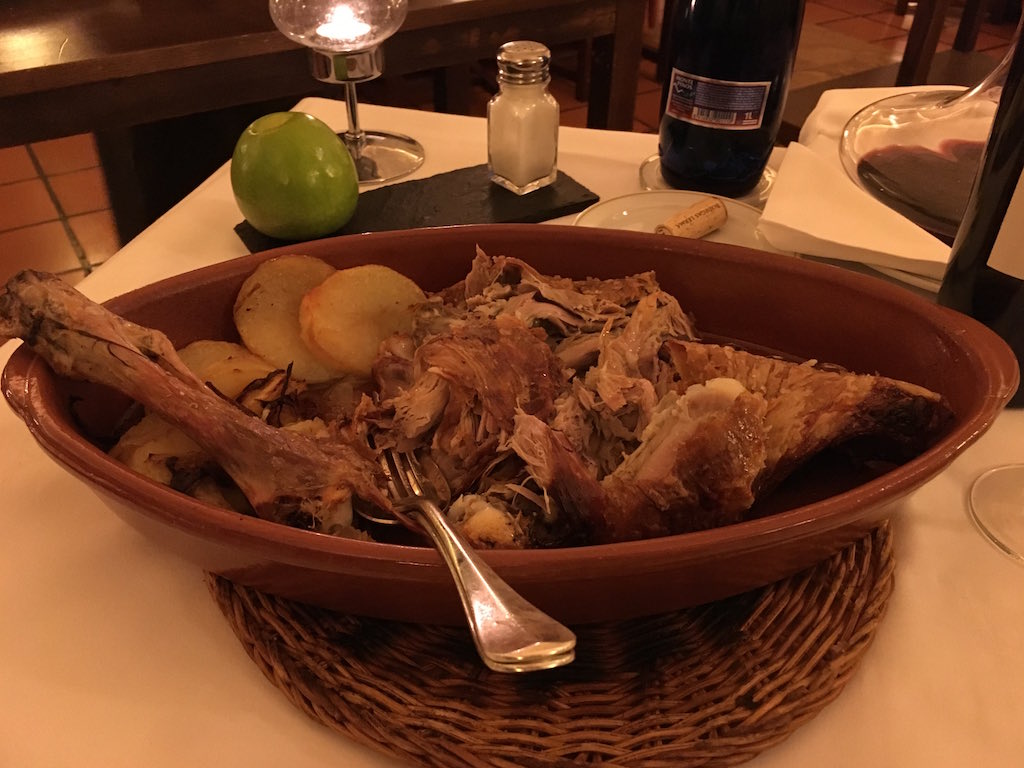
It is a meat dish after all.
When I think of Spanish food, I don’t mean… paella!
When you think of Spanish food, you probably think of “paella”, but this dish is popular in Valencia and Catalonia on the Mediterranean side, and you don’t see it much in other areas except in big cities like Madrid. (This is the one we had in Barcelona)

Not only in the countryside of Aragon and the Basque Country, but also in the city, for example in San Sebastian (Donostia) in the Basque Country, which is famous for its gastronomy, I didn’t see many restaurants serving paella as long as I walked around the city. The same goes for the local paradors. The restaurants serve mainly the local traditional cuisine, so we rarely saw it in the areas we stayed, Castile, Aragon and Basque.
Traditional Spanish meat dishes:.
After all, being in Europe, meat dishes are delicious. There are many kinds of meat such as veal (Chuleton), suckling pig (Cochinillo Asado), lamb (Cordero Asado) and rabbit. All of these are also commonly eaten in France, but the Spanish way of cooking is more bold and wild. Perhaps that’s why the taste is also a bit wild.
The calf (Chuleton Chuleton) is at the Parador de Sigüenza.

Little piglet (Cochinillo Asado Cochinillo Asado) in Zaragoza.

And the lamb (Cordero Asado) was served at the Parador in Lerma.

It was very tasty.
Doesn’t garlic in Spain smell bad?
By the way, garlic is often used in Spanish cuisine, but strangely enough, the smell was not too strong and mild. For example, I had a garlic soup called “Soba de ajo”, a specialty of Castile, at the parador in Lerma. It’s the one in the upper part of the photo. Sorry it’s hard to see.

You can think of it as a version of the onion gratin soup that you often see in Japanese family restaurants, but with garlic instead of onions. It’s certainly full of garlic and has a strong aroma, but it doesn’t have a strong odor at all, and there’s almost no smell that lingers the next day. (There are rumors that it’s just my imagination though lol)
The French have the better bread.
As for bread, Spain is also good, but I didn’t feel it was as good as France. But I didn’t feel it was as good as France.

I was surprised that the sandwich bread I bought in French Basque was so delicious, yes this deliciousness is French. The one in Spain did not impress me so much. Great France.
Cheese (Queso)
Of course, there is cheese in Spain, too. Santillana del Mar, where I stayed this time, is a beautiful village in Cantabria, and I heard that Cantabria has a lot of good cheese because of its dairy farming. At the parador where we stayed, we ordered a platter of local cheese as an appetizer.

You can also order a cheese platter in Castilla La Mancha, mainly in Madrid.

It was delicious too. I felt that I need to learn more about Spanish cheese. I still lack knowledge.
The set meal (menu) also comes with water and a bottle of wine by default.
By the way, this was a happy miscalculation, but in some local restaurants, if you order the set meal of the day (menu du jour in Spanish), a bottle of wine (perhaps red?) is included by default. It depends on the place).
The paradors in Lerma and Santillana del Mar and the restaurants in San Sebastián and Huesca were in this format. However, the wines are not bad, but they are quite ordinary, so if you want a higher quality wine, you need to ask for a different wine. On this occasion, the default wine did not come with us.
It also comes with water. If you don’t say anything, you will get a bottle of water without gas.

I’m very grateful.
Dessert (postre)
There’s a good selection of desserts, but perhaps the most Spanish of all is the flan.

It is a so-called “baked pudding”. It doesn’t contain any fresh cream, and is the opposite of the fluffy pudding that you see so often in Japan these days. The hard type makes bubbles, but I think this also gives it a good texture.
By the way, “Crema Catalana” is a French word for crème brûlée. I often saw it in Catalonia.

There were a few other delicious desserts, but I found myself ordering only this flan.
Maybe the menu should be in Spanish.
Because the English translation is too lazy, and because English (probably) has a limited vocabulary, sometimes the only thing that is correct is the ingredients, and the cooking methods, etc. are not explained correctly. I think it’s better not to.

Nowadays, Spanish is better because you can look it up quickly on your smartphone or other devices. This is also the case in France.
食事とワイン編はあともう1回続きます。


